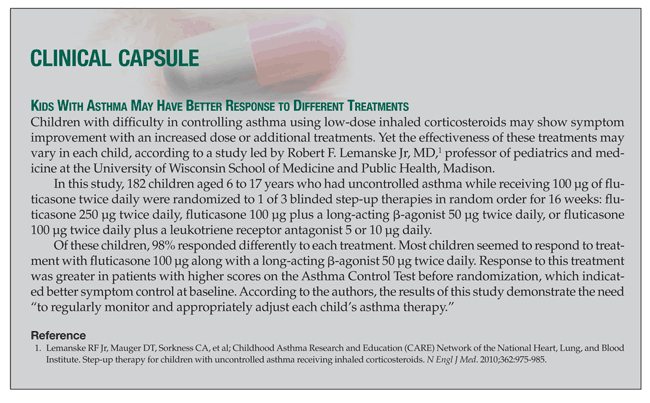- Clinical Technology
- Adult Immunization
- Hepatology
- Pediatric Immunization
- Screening
- Psychiatry
- Allergy
- Women's Health
- Cardiology
- Pediatrics
- Dermatology
- Endocrinology
- Pain Management
- Gastroenterology
- Infectious Disease
- Obesity Medicine
- Rheumatology
- Nephrology
- Neurology
- Pulmonology
Comparative Effectiveness Research-Part 2: The Impact on Decision Making
As publicly funded health care payment programs have grown over decades because of demographic shifts and expansion of coverage, comparative effectiveness research (CER) has emerged to address value in health care. The American Recovery and Reinvestment Act of 2008 (ARRA) included $1.1 billion for CER initiatives, and the new health care legislation created the Patient-Centered Outcomes Research Institute, which will be funded with $500 million or more annually. In these efforts exist the promise to create informed decisions that will improve health care at both the individual and population levels.

As publicly funded health care payment programs have grown over decades because of demographic shifts and expansion of coverage, comparative effectiveness research (CER) has emerged to address value in health care. The American Recovery and Reinvestment Act of 2008 (ARRA) included $1.1 billion for CER initiatives, and the new health care legislation created the Patient-Centered Outcomes Research Institute, which will be funded with $500 million or more annually. In these efforts exist the promise to create informed decisions that will improve health care at both the individual and population levels.
Mark McClellan, MD, PhD, director of the Engelberg Center for Health Care Reform at the Brookings Institution in Washington, DC, has been a vocal advocate of change in the traditional Washington corridors of power as well as an early advocate for CER and better intra-agency collaboration to deal with clinical and economic issues. Although there are growing concerns that more than half of the federal budget will be spent on health care by mid-decade, little has changed among the respective federal health care agencies (NIH, FDA, CDC, Agency for Healthcare and Research Quality) with jurisdiction in health care matters that have their own turf and funding battles to wage among the congressional budget wars each year. Yet, all agree to the need for evidence and the dissemination of knowledge through various methods, including expert panels.
Nonetheless, whether an approach like CER can rely solely on the medical literature and medical experts was debated during the early years of the HIV/AIDS epidemic in the United States. Use of double-blind randomized studies advocated from the scientific community, rather than open-label studies or registries by AIDS activists, has provided robust data around the world for clinical decision making. More specifically for CER under ARRA, the key question remains whether federal agencies and NIH researchers adequately represent community standards of practice in order to determine the appropriateness of clinical care delivered to individuals or populations of patients covered through government-sponsored health care programs.
Private Sector Adaptation
Over the past few years, there has been a decrease in the percentage of persons who receive health care coverage from commercial plans, but private sector programs continue to cover the majority of Americans. On the basis of the successes and failures of public sector programs, the commercial insurance plans have adopted various strategies and improvements in managing systems of care. Since 1965, government health care program cost overruns have been consistent. Many of those public sector benefit management strategies are inexorably tied to funding. So is the value of CER in determining the economics of health care or clinical quality?
In the private sector, there may be a focus on CER and economic benefits over the next few years in an effort to generate trend management savings once generic biologic products are available. Already we have seen different strategies emerge among PBMs to address product category shifts. These efforts include intense lobbying for follow-on biologic approval pathways, shortened patent terms for biologics, and using CER methods to determine therapeutic interchange opportunities among biologic products independent of less timely or available manufacturer-funded data and federal government data. It is likely that this research will impact all the biopharmaceutical products and indications in existing or new benefit coverage designs by commercial plans.
What we do know from studies in public and private sector programs is that cost shifting affects prescription drug use, but we are not certain about the long-term consequences of benefit changes on health, especially in chronic disease.1 Once economic data from CER become available and begin to effect P&T decision making in the marketplace, it is difficult to anticipate the response of patients enrolled in private and public sector health plans.
PBM initiatives. As mentioned above, a number of PBMs have developed strategies to address product category shifts. Express Scripts has been advocating for a legislative pathway over the past several years and was active in the health care reform debate to ensure the earliest possible stream of follow-on biologics. Such an approach is consistent with the Express Scripts early positioning of small-molecule branded products for aggressive switching once generics become available.
Medco established the first personalized medicine service offering to employer clients, which is designed to put results from research into clinical practice. Starting with 4 medication-related areas, Medco offers an integration of drug-related diagnostics with therapeutic agents in order to confirm or optimize appropriate therapies that would be covered under a benefit plan. As part of this area of research, Medco may conduct studies from its client roster that could allow the company to actively compare products, such as prasugrel versus clopidogrel in select cardiovascular syndromes. Such market-focused research could result in active therapeutic substitution based on the proprietary real-world data emanating from a PBM and not the manufacturer.
One final example from UnitedHealthcare illustrates the expanding role in the use of guidelines to drive reductions in unnecessary care that does not improve health and raises care cost. As part of the long-standing effort with expert groups in cancer treatment, doctors are sent individualized reports assessing their treatment versus established guidelines for care of select cancers, such as breast, colorectal, and lung cancers. Cancer remains 1 of the top 3 most expensive diseases, and programs led by organizations such as UnitedHealthcare illustrate the desire to push forward and make changes to the delivery of patient care.
How Does CER Impact Decision Making?
According to the Institute of Medicine (IOM), CER compares the benefits and harms of methods to prevent, diagnose, treat, and monitor a health condition or to improve the delivery of care.2 For members of P&T committees and other decision-making groups assessing new technologies for safety, effectiveness, and value to improving patient outcomes within their organization, how will CER be of assistance? The use or lack of innovation in medication therapies can have a great impact on all stakeholders who make decisions in health care. Reports from the IOM suggest that CER will be designed to reduce system inefficiencies with medications that include overuse, misuse, and underuse.3
As information technologies and systems as well as third-party adjudication processes become more sophisticated, the ability to draw actionable and meaningful patient outcomes from systems used in the delivery of medications gets easier.4 It is expected that increased CER will derive data from the payer communities, but it is difficult to determine whether the promise in fostering better innovation and information long term also dampens investments short term among manufacturers. Will the anticipated diagnostic, treatment, and device options that are the lifeblood of health care companies dim in the light of CER studies?
Regulatory agencies must take care in adjusting to the increased amount of information and avoid sending mixed signals to providers and manufacturers as well as to patients about the appropriate use of medications. This could happen as a result of an inability to demonstrate results in a reproducible, timely manner required for diagnostic or device investment or to conduct appropriate comparisons of emerging research compounds and established brands of pharmaceuticals. Such a conversion among various sources of information would certainly affect the emergence of personalized medicine as well as its reimbursement under current standards of practice.
In the past decade, a conversation began about the frustration with CER and the reality versus promise for health plan and institutional P&T committees. In this next decade of health care, we may see an increase in frustration or a clearer path toward realizing the promise of CER in determining appropriate use and in delivering prudent economic outcomes to private and public sector plan sponsors. Alternatively, there is a valid argument that there be an effort toward innovation in health care insurance financing that addresses the key issues and drivers seen in contemporary health care program plans.
Determining Value
In the first part of this series, the shift in decision making from the patient to various third parties during the past century was discussed. Over time, that shift included pharmaceutical products and the establishment of new applications of economic analysis around medication use as well as formulary decisions as part of the search for value in spending on medications. The private sector insurance programs came first, but over time, the growing public sector programs also began to face similar economic issues. Public sector programs, including the Department of Veterans Affairs and the military, began to use various economic analyses as part of their coverage decision-making determinations and implemented changes that were also adapted or used by the private sector.

The nagging questions that remain unanswered lie philosophically in the determination of value, given the numerous perspectives, and realization of value as an economic outcome versus health status in the marketplace. As drug benefit managers grapple with the increasing trend, issues to be considered remain numerous as they try to balance the various perspectives of value among stakeholders in the benefit plans they manage. Some of those issues include the following:
• How useful is CER as a tool to deal with the integrated clinical outcomes of the patient if trend management is only done in a pharmacy budget silo?
• How can public and private plan sponsor expectations of outcomes be reconciled?
• How can information from CER be applied in a relative value-based but plan sponsor–focused commercial or government mandate–driven program? Managers and advisors on drug benefit programs and trends will need to reshape strategies and implementation of appropriate medication use programs in order to sustain success during this decade.
Editor’s note: The first article in this series (Drug Benefit Trends. 2010;22:46-48) reviewed the evolution of health care payment in the United States and the origins of comparative effectiveness research (CER). This article discusses the relevance of CER in both public and private sector benefit plans and potential applications of this research within this decade.
References:
References
1. Goldman DP, Joyce GF, Zheng Y. Prescription drug cost sharing: associations with medication and medical utilization and spending and health. JAMA. 2007;298:61-69.
2. Institute of Medicine. Initial national priorities for comparative effectiveness research. Report brief. June 2009. http://grants.nih.gov/grants/guide/rfa-files/RFA-HS-10-010.html. Accessed March 11, 2010.
3. Institute of Medicine Roundtable on Evidence-Based Medicine. Learning what works best: the nation’s need for evidence on comparative effectiveness in health care, September 2007. http://www.iom.edu/~/media/Files/ Activity%20Files/Quality/EBM/ComparativeEffectivenessWhitePaperESF. ashx. Accessed February 11, 2010.
4. Basta N. Comparative effectiveness with the gloves off. Pharmaceutical Commerce. October 31, 2009. http://www.pharmaceuticalcommerce.com/ frontEnd/1312-comparative_effectiveness_Medco_AHRQ_Plavix_Effient. html. Accessed March 11, 2010.
Common Side Effects of Antiretroviral Therapy in HIV Infection
February 7th 2013What are some of the more common side effects of antiretroviral therapy, and what can the primary care physician do to help manage these effects? In this podcast, infectious disease expert Rodger MacArthur, MD, offers insights and points readers to updated comprehensive guidelines.
